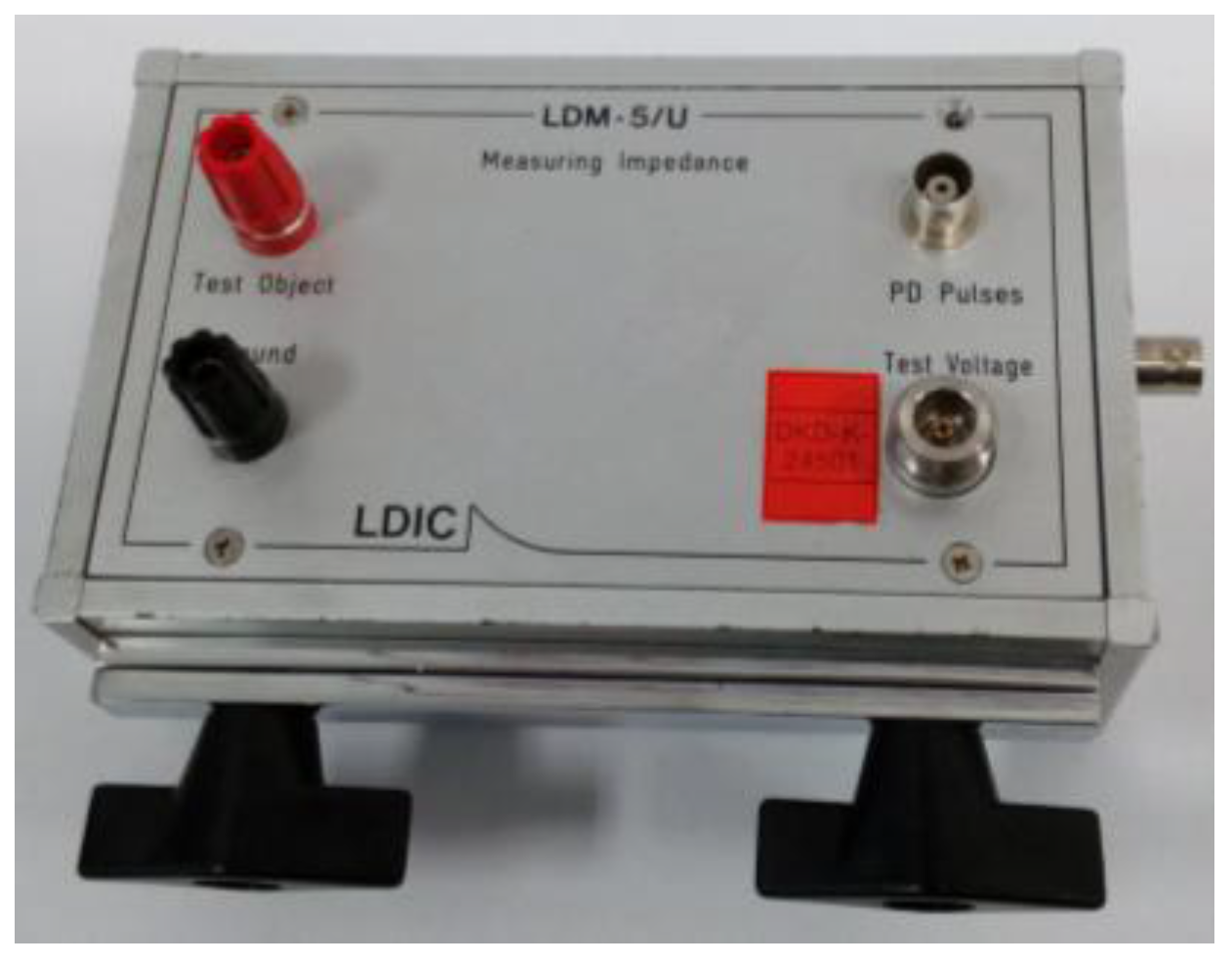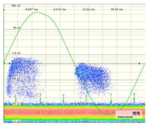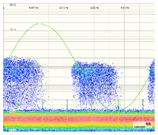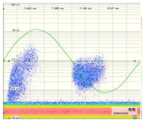Diagnosis of Insulation Condition of MV Switchgears by Application of Different Partial Discharge Measuring Methods and Sensors
Abstract
:1. Introduction
2. Measuring Methods, Sensors, and Measurement Devices
2.1. Measuring Methods
- High sensitivity is obtained when the sensors are located close to the PD source and when they are hundreds of meters from it. Hence, as mentioned before, with this method a high field of vision is achieved and use of a few measuring units positioned in strategic points in a MV installation is sufficient for its supervision.
- If two or more HFCT sensors are placed in a MV or HV installation, the measurement of the PD pulses with a common time reference allows the location of the defects by the time-of-flight analysis.
- High immunity to electric noise interferences and corona discharges in air, since the frequency spectrum of these signals in the UHF range is very low and in some emplacements negligible.
- High sensitivity in PD detection inside the metal enclosed switchgears due to the inner electrical resonance and low-inherent losses.
- Possibility of assuring that when an insulation defect is detected with an antenna placed in a switchgear, this defect is confined inside this switchgear (including the cable terminations connected to it).
2.2. PD Sensors
2.3. PD Measurement Devices and Switchgear Cabinet
3. Experimental Setup
4. Experimental Measurements
4.1. Measurement of the Internal Defect
- -
- Regarding the insulation defect detection:
- ◾
- Sensitivity in the detection.
- ◾
- Analytical capability for the assisted or autonomous detection.
- -
- Regarding the type of defect identification:
- ◾
- Analytical capability for the assisted or autonomous defect recognition.
- -
- Regarding the defect location (determination of the MV switchgear where the PD source is present and identification of the defective element inside it):
- ◾
- Analytical capability for the assisted or autonomous identification of the affected MV switchgear and for the identification of the defective element (cable termination or rest of components).
4.2. Measurement of the Surface Defect
5. Discussion
6. Conclusions
Acknowledgments
Author Contributions
Conflicts of Interest
References
- Steennis, F.; Wagenaars, P.; van der Wielen, P.; Wouters, P.; Li, Y.; Broersma, T.; Harmsen, D.; Bleeker, P. Guarding MV cables on-line: With travelling wave based temperature monitoring, fault location, PD location and PD related remaining life aspects. IEEE Trans. Dielectr. Electr. Insul. 2016, 33, 1562–1569. [Google Scholar] [CrossRef]
- Judd, M.; Yang, L.; Hunter, I. Partial discharge monitoring of power transformers using UHF sensors. Part I: Sensors and signal interpretation. IEEE Electr. Insul. Mag. 2005, 21, 5–14. [Google Scholar]
- Markalous, S.; Tenbohlen, S.; Feser, K. Detection and location of partial discharges in power transformers using acoustic and electromagnetic signals. IEEE Trans. Dielectr. Electr. Insul. 2008, 15, 1576–1583. [Google Scholar] [CrossRef]
- Nandi, S.; Toliyat, H.A.; Li, X. Condition monitoring and fault diagnosis of electrical motors—A review. IEEE Trans. Energy Conv. 2005, 4, 719–729. [Google Scholar] [CrossRef]
- Pryor, B.M. A review of partial discharge monitoring in gas insulated substations. In Proceedings of the IEE Colloquium on Partial Discharges in Gas Insulated Substations, London, UK, May 1994. [Google Scholar]
- Min, C.; Urano, K.; Jian, T.; Zhongwei, Q.; Jinno, A. Application of online PD monitoring system using HF/UHF PD sensors for GIS and cable. In Proceedings of the International Conference on Condition Monitoring and Diagnosis (CMD), Tokyo, Japan, 6–11 September 2010. [Google Scholar]
- Haddad, A.; Warne, D.F. Advances in High Voltage Engineering, 2nd ed.; IET Power and Energy Series; IET: London, UK, 2007; pp. 37–190. [Google Scholar]
- Tian, Y.; Lewin, P.; Davies, A. Comparison of on-line partial discharge detection methods for HV cable joints. IEEE Trans. Dielectr. Electr. Insul. 2002, 9, 604–615. [Google Scholar] [CrossRef]
- Wang, X.; Li, B.; Roman, H.; Russo, O.L.; Chin, K.; Farmer, K.R. Acousto-optical PD Detection for Transformers. IEEE Trans. Power Deliv. 2006, 21, 1068–1073. [Google Scholar] [CrossRef]
- Wang, L.; Fang, N.; Wu, C.; Qin, H.; Huang, Z. A fiber optic PD sensor using a balanced Sagnac interferometer and an EDFA-based DOP tunable fiber ring laser. Sensors 2014, 14, 8398–8422. [Google Scholar] [CrossRef] [PubMed]
- Posada-Roman, J.; Garcia-Souto, J.A.; Rubio-Serrano, J. Fiber Optic Sensor for Acoustic Detection of Partial Discharges in Oil-Paper Insulated Electrical Systems. Sensors 2012, 12, 4793–4802. [Google Scholar] [CrossRef] [PubMed]
- Álvarez, F.; Ortego, J.; Garnacho, F.; Sánchez-Urán, M.A. Advanced techniques for on-line PD measurements in high voltage systems. In Proceedings of the International Conference on High Voltage Engineering and Application (ICHVE), Poznan, Poland, 8–11 September 2014. [Google Scholar]
- Álvarez, F.; Garnacho, F.; Albarracín, R.; Granizo, R.; Dong, M.; Ortego, J. Practical experience of insulation condition evaluation in an on-site HV installation applying a PD measuring procedure. In Proceedings of the International Conference on Condition Monitoring and Diagnosis (CMD), Xi’an, China, 25–28 September 2016. [Google Scholar]
- Ardila-Rey, J.A.; Rojas-Moreno, M.V.; Martínez-Tarifa, J.M.; Robles, G. Inductive sensor performance in partial discharges and noise separation by means of spectral power ratios. Sensors 2014, 14, 3408–3427. [Google Scholar] [CrossRef] [PubMed]
- Álvarez, F.; Garnacho, F.; Ortego, J.; Sánchez-Urán, M.A. Application of HFCT and UHF sensors in on-Line partial discharge measurements for insulation diagnosis of high voltage equipment. Sensors 2015, 15, 7360–7387. [Google Scholar] [CrossRef] [PubMed]
- Hussain, G.A.; Shafiq, M.; Kumpulainen, L.; Mahmood, F.; Lehtonen, M. Performance evaluation of noise reduction method during on-line monitoring of MV switchgear for PD measurements by non-intrusive sensors. Int. J. Electr. Power Energy Syst. 2015, 64, 596–607. [Google Scholar] [CrossRef]
- Zhang, X.; Cheng, Z.; Gui, Y. Design of a new built-in UHF multi-frequency antenna sensor for partial discharge detection in high-voltage switchgears. Sensors 2016, 16, 1170. [Google Scholar] [CrossRef] [PubMed]
- Kang, W.; Lee, D.; Ham, S.; Lee, J.; Lee, J.; Kim, D.; Kwon, T. Development of a UHF PD detection system to estimate the dielectric condition of a medium voltage switchgear. In Proceedings of the IEEE International Symposium on Electrical Insulation, ISEI, Vancouver, BC, Canada, 9–12 June 2008; pp. 377–380. [Google Scholar]
- IEC-62478. High-Voltage Test Techniques—Measurement of Partial Discharges by Electromagnetic and Acoustic Methods. Proposed Horizontal Standard, 1st ed.; International Electrotechnical Commission (IEC): Geneva, Switzerland, 2016. [Google Scholar]
- International Standard IEC 60270. High Voltage Test Techniques—Partial Discharge Measurements, 3rd ed.; International Electrotechnical Commission: Geneva, Switzerland, 2000. [Google Scholar]
- Lemke, E. Guide for Partial Discharge Measurement in Compliance to IEC 60270 Std; CIGRE Technical Brochure; CIGRE: Paris, France, 2008; Available online: https://pure.tugraz.at/portal/files/1570877/ELT_241_7.pdf (acccessed on 28 February 2018).
- Koltunowicz, W.; Plath, R. Synchronous multi-channel PD measurements. IEEE Trans. Dielectr. Electr. Insul. 2018, 15, 1715–1723. [Google Scholar] [CrossRef]
- Robles, G.; Albarracín, R.; Vázquez, J.L. Antennas in Partial Discharge Sensing System. In Handbook of Antenna Technologies; Chen, Z.N., Ed.; Springer: Singapore, 2015; pp. 1–47. [Google Scholar]
- Li, T.; Rong, M.; Zheng, C.; Wang, X. Development simulation and experiment study on UHF partial discharge sensor in GIS. IEEE Trans. Dielectr. Electr. Insul. 2012, 19, 1421–1430. [Google Scholar] [CrossRef]
- Luo, Y.; Li, Z.; Wang, H. A review of online partial discharge measurement of large generators. Energies 2017, 10, 1694. [Google Scholar] [CrossRef]
- Garnacho, F.; Ortego, J.; Sánchez-Urán, M.A.; Álvarez, F.; González, A. On line PD monitoring of short cable systems installed in substations. In Proceedings of the JICABLE, Versailles, France, 21–24 June 2015. [Google Scholar]
- Garnacho, F.; Ortego, J.; Álvarez, F.; Sánchez-Urán, M.A. Non invasive PD monitoring for power transformers. In Proceedings of the 5th International Advanced Research Workshop on Transformers, Pontevedra, Spain, 3–5 October 2016. [Google Scholar]
- Andle, J.C.; Murray, J.P.; Chap, M.; Baquero, E.; Jordan, J.T. Ubiquitous UHF monitoring system for partial discharge detection and trending. In Proceedings of the IEEE Innovative Smart Grid Technologies—Asia (ISGT ASIA), Bangkok, Thailand, 3–6 November 2015. [Google Scholar]
- Mulroy, P.; Hurtado, A.; Badetz, D. On-line partial discharge monitoring system for distribution networks. In Proceedings of the International Conference on Condition Monitoring and Diagnosis (CMD), Bali, Indonesia, 23–27 September 2012. [Google Scholar]
- Gilbert, I.; Mulroy, P.; Hurtado, A.; Akroud, N.; Orue, I. Practical experience of a partial discharge monitoring application on an experimentation MV distribution network. In Proceedings of the CIRED 23rd International Conference on Electricity Distribution, Lyon, France, 15–18 June 2015. [Google Scholar]
- Albarracín, R.; Ardila-Rey, J.A.; Mas’ud, A.A. On the use of monopole antennas for determining the effect of the enclosure of a power transformer tank in partial discharges electromagnetic propagation. Sensors 2016, 16, 148. [Google Scholar] [CrossRef] [PubMed]
- Robles, G.; Sánchez-Fernández, M.; Albarracín-Sánchez, R.; Rojas-Moreno, M.; Rajo-Iglesias, E.; Martínez-Tarifa, J. Antenna parametrization for the detection of partial discharges. IEEE Trans. Instrum. Meas. 2013, 62, 932–941. [Google Scholar] [CrossRef] [Green Version]
- Balanis, C.A. Antenna Theory: Analysis and Design, 3rd ed.; Wiley-Interscience: Hoboken, NJ, USA, 2005. [Google Scholar]
- Balanis, C.A. Advanced Engineering Electromagnetics, 2nd ed.; Wiley: Hoboken, NJ, USA, 2012. [Google Scholar]
- Cheng, D.K. Fundamentals of Electromagnetism Engineering; Addison Wesley Iberoamericana: Mexico DF, Mexico, 1998. [Google Scholar]
















| Measuring Method | Measuring Technique | Sensor | Frequency Range |
|---|---|---|---|
| 1 | UHF | UHF Antenna | UHF |
| 2 | HF | HFCT | HF |
| 3 | IEC 60270 | Quadrupole | <1 MHz |
| Number of Element | Component of the Setup |
|---|---|
| 1 | Autotransformer (voltage regulator), 0–250 V, 3 kVA |
| 2 | HV transformer 110 V/66 kV, 600 VA |
| 3 | Blocking impedance |
| 4 | Capacitive divider and measuring quadrupole (according to IEC 60270) |
| 5 | MV power cable |
| 6 | Accessible part of the MV metal cabinet |
| 7 | Test cell with insulation defect |
| 8 | Circuit breaker and bus duct compartment |
| Measuring Method | Sensor | Measuring Point | Measuring Frequency Range |
|---|---|---|---|
| UHF | UHF Antenna | 1 | 225–375, 475–750 and 1000–1500 MHz |
| HF | HFCT | 2 | 10 kHz–20 MHz |
| IEC 60270 | Quadrupole | 3 | <1 MHz |
| Voltage Level | Method Two (HF) Sensor: HFCT Equipment: BlueBOX | Method Three (IEC 60270) Sensor: Quadrupole Equipment: Mtronix | ||
|---|---|---|---|---|
| 10 kV |  | Rate: 2 PDs/cycle Amplitude: 47 mV Max. amplitude by semi period: “+”: 105 mV “−”: 60 mV |  | Rate: 3 PDs/cycle Charge: 336 pC Max. charge by semi period: “+”: 717 pC “−”: 510 pC |
| 12 kV |  | Rate: 11 PDs/cycle Amplitude: 85 mV Max. amplitude by semi period: “+”: 140 mV “−”: 85 mV |  | Rate: 9 PDs/cycle Charge: 527 pC Max. charge by semi period: “+”: 800 pC “−”: 530 pC |
| 15 kV |  | Rate: 14 PDs/cycle Amplitude: 114 mV Max. amplitude by semi period: “+”: 162 mV “−”: 93 mV |  | Rate: 12 PDs/cycle Charge: 635 pC Max. charge by semi period: “+”: 970 pC “−”: 720 pC |
| 19 kV |  | Rate: 24 PDs/cycle Amplitude: 121 mV Max. amplitude by semi period: “+”: 165 mV “−”: 116 mV |  | Rate: 20 PDs/cycle Charge: 698 pC Max. charge by semi period: “+”: 1.2 nC “−”: 868 pC |
| Voltage Level | Method Two (HF) Sensor: HFCT Equipment: BlueBOX | Method Three (IEC 60270) Sensor: Quadrupole Equipment: Mtronix | ||
|---|---|---|---|---|
| 11.5 kV |  | Rate: 3 PDs/cycle Amplitude: 74 mV Max. amplitude by semi period: “+”:101 mV “−”: 112 mV |  | Rate: 3 PDs/cycle Charge: 512 pC Max. charge by semi period: “+”: 1.4 nC “−”: 1.1 nC |
| 15 kV |  | Rate: 12 PDs/cycle Amplitude: 174 mV Max. amplitude by semi period: “+”: 307 mV “−”: 170 mV |  | Rate: 10 PDs/cycle Charge: 1.6 nC Max. charge by semi period: “+”: 4 nC “−”: 1.5 nC |
| 17 kV |  | Rate: 17 PDs/cycle Amplitude: 206 mV Max. amplitude by semi period: “+”: 285 mV “−”: 214 mV |  | Rate: 15 PDs/cycle Charge: 2 nC Max. charge by semi period: “+”: 4 nC “−”: 1.5 nC |
| 19 kV |  | Rate: 20 PDs/cycle Amplitude: 201 mV Max. amplitude by semi period: “+”: 325 mV “−”: 265 mV |  | Rate: 17 PDs/cycle Charge: 2.4 nC Max. charge by semi period: “+”: 4 nC “−”: 2.9 nC |
| Method | Insulation Defect Detection | Insulation Defect Identification | Insulation Defect Location (1) | Defected Element Identification (2) | ||||
|---|---|---|---|---|---|---|---|---|
| Autonomous | Detection (Sensitivity) | Autonomous | Identification | Autonomous | Location | Autonomous | Identification | |
| 1 (UHF) |  |  |  |  |  |  |  |  |
| 2 (HF) |  |  |  |  |  |  |  |  |
| 1&2 (UHF&HF) |  |  |  |  |  |  |  |  |
 Achieved
Achieved  Not totally achieved
Not totally achieved  Not achieved. (1) Localization in the supervised installation of the MV switchgear where the insulation defect is present. (2) Identification of the defective element inside the switchgear (cable termination or rest of components).
Not achieved. (1) Localization in the supervised installation of the MV switchgear where the insulation defect is present. (2) Identification of the defective element inside the switchgear (cable termination or rest of components).© 2018 by the authors. Licensee MDPI, Basel, Switzerland. This article is an open access article distributed under the terms and conditions of the Creative Commons Attribution (CC BY) license (http://creativecommons.org/licenses/by/4.0/).
Share and Cite
Álvarez Gómez, F.; Albarracín-Sánchez, R.; Garnacho Vecino, F.; Granizo Arrabé, R. Diagnosis of Insulation Condition of MV Switchgears by Application of Different Partial Discharge Measuring Methods and Sensors. Sensors 2018, 18, 720. https://doi.org/10.3390/s18030720
Álvarez Gómez F, Albarracín-Sánchez R, Garnacho Vecino F, Granizo Arrabé R. Diagnosis of Insulation Condition of MV Switchgears by Application of Different Partial Discharge Measuring Methods and Sensors. Sensors. 2018; 18(3):720. https://doi.org/10.3390/s18030720
Chicago/Turabian StyleÁlvarez Gómez, Fernando, Ricardo Albarracín-Sánchez, Fernando Garnacho Vecino, and Ricardo Granizo Arrabé. 2018. "Diagnosis of Insulation Condition of MV Switchgears by Application of Different Partial Discharge Measuring Methods and Sensors" Sensors 18, no. 3: 720. https://doi.org/10.3390/s18030720
APA StyleÁlvarez Gómez, F., Albarracín-Sánchez, R., Garnacho Vecino, F., & Granizo Arrabé, R. (2018). Diagnosis of Insulation Condition of MV Switchgears by Application of Different Partial Discharge Measuring Methods and Sensors. Sensors, 18(3), 720. https://doi.org/10.3390/s18030720






